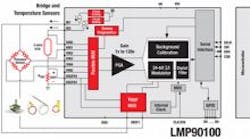Sensors can measure all manner of physical properties. Whether it's pressure, temperature, humidity, pH, conductivity, or other unknown, there's a sensor out there to measure it. But once the measurement is taken, what happens to that data? Early system typically displayed the reading or possibly recorded it to paper using a pen positioned on a roll of graph paper. Voltage level sensors could monitor conditions based on established set points, but had no means of taking any action until that set point was reached.Microprocessors brought flexibility to sensor measurements, adding the capacity to monitor trends that lets the control system take corrective measures before a specific setpoint was reached. However, the raw analog output of the sensor could never plug directly into the digital circuitry of the microprocessor. The signal had to be conditioned, filtered, smoothed, and scaled first, then converted to a digital value before the microprocessor would even look at it. The circuitry needed to perform these tasks added complexity and cost to an ostensibly simple sensor.Texas Instruments saw the call for simplifying sensor connectivity. Their LMP90xxx and LMP91xxx line of analog front ends (AFEs) for sensor applications was their reply. The AFEs connect directly to the sensor on one side, and directly to a microprocessor control system on the other, providing all of the "glue" necessary to bind the analog and digital worlds together.For example, the LMP90xxx series handles temperature, pressure, load, force, and other general-purpose sensors. Depending on the model, the AFE devices feature a fully configurable 16 or 24-bit ΣΔ ADC. The true continuous background calibration of the ADC helps eliminates gain and offset drift over time and temperature. The sensor connections supply any standard voltage or current needed, such as for RTD temperature probes or bridge-style strain-gages. A multiplex input handles four differential, seven single-ended inputs, or any combination of the two.The LMP91xxx line handles specific applications that the LMP90xxx series can't. For example, the LMP91050 is optimized for thermopile sensors, such as those typically used in NDIR applications. The LMP91000 is optimized for gas and checmical sensing using three-wire sensors while the LMP91200 handles sensors with two electrodes, such as those used in pH measurement.
About the Author
Sign up for our eNewsletters
Get the latest news and updates
